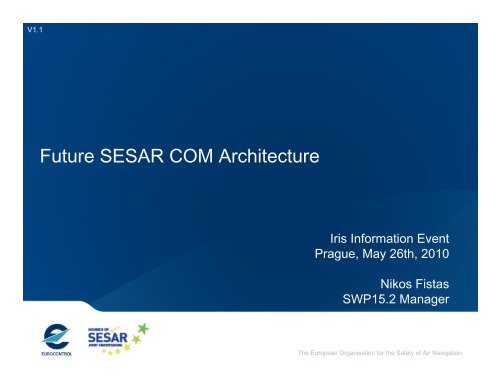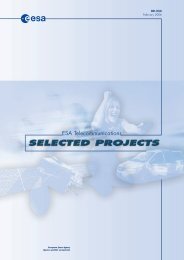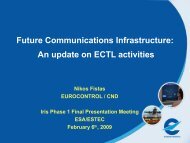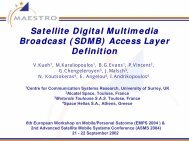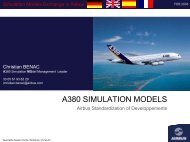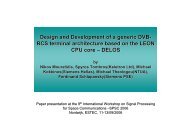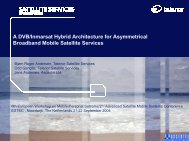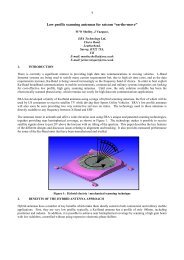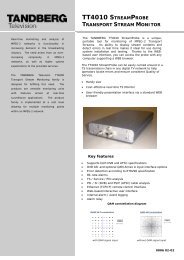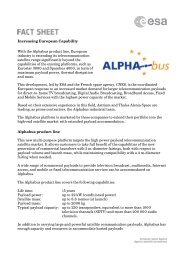Future SESAR COM Architecture
Future SESAR COM Architecture
Future SESAR COM Architecture
Create successful ePaper yourself
Turn your PDF publications into a flip-book with our unique Google optimized e-Paper software.
V1.1<br />
<strong>Future</strong> <strong>SESAR</strong> <strong>COM</strong> <strong>Architecture</strong><br />
Iris Information Event<br />
Prague, May 26th, 2010<br />
Nikos Fistas<br />
SWP15.2 Manager<br />
The European Organisation for the Safety of Air Navigation
Agenda<br />
1) <strong>Future</strong> Aeronautical Communications – Key Assumptions<br />
2) <strong>Future</strong> data links in the <strong>SESAR</strong> context<br />
3) Terrestrial Data Links<br />
• LDACS: <strong>SESAR</strong> project P15.2.4<br />
• AEROMACS: <strong>SESAR</strong> project P15.2.7<br />
2
Basic Assumptions (1/2)<br />
• <strong>Future</strong> (2020+) system needs to support ATS and AOC end-toend<br />
communications including air/ground and air/air<br />
• In future operating concept data becomes the primary mode of<br />
communications<br />
• In case of failure of data com, voice is unlikely to be able to<br />
sustain operations at the same capacity level. Therefore<br />
different data links may be needed to maintain capacity of<br />
operations<br />
• In the future concept voice will remain available for emergency<br />
communications<br />
3
Basic Assumptions (2/2)<br />
• No single technology meets all requirements across all<br />
operational flight domains<br />
• <strong>Future</strong> system will be a system of systems integrating existing<br />
communication systems (voice, VDL) as well as new<br />
communications systems to meet the operational requirements<br />
(Airborne) Integration of technologies needs to be facilitated<br />
• <strong>Future</strong> system should support digital voice in the long term,<br />
however in the short term the emphasis is to support data<br />
communications<br />
• Appropriate spectrum allocations: AM(R)S and AMS(R)S<br />
4
Baseline of current work<br />
5
Legacy systems and New Data Links<br />
Legacy Systems<br />
Multilink<br />
Concept<br />
Airport surface: C band<br />
General terrestrial: L Band<br />
Satellite: Oceanic + Continental<br />
6
FCI: <strong>Future</strong> Com Infrastructure<br />
• Enabler supporting the realisation of <strong>SESAR</strong> objectives<br />
(especially in terms of safety and capacity)<br />
• Global standards and support for worldwide interoperability<br />
7
SJU WBS<br />
<strong>SESAR</strong> Programme<br />
WP B WP C WP D<br />
Target Concept &<br />
<strong>Architecture</strong> Maintenance<br />
Master Plan<br />
Maintenance<br />
ATM Network R&D<br />
Programme<br />
WP 3<br />
Validation<br />
Infrastructure<br />
WP 16<br />
R&D Transversal<br />
Areas<br />
WP 7<br />
Network<br />
Operation<br />
WP 4<br />
En Route<br />
Operation<br />
WP 5 WP 8 WP 14 W 11 WP 15 WP 13<br />
TMA Information SWIM F/WOC CNS Network<br />
Operation Management<br />
Information<br />
Management<br />
SWIM Thread<br />
Systems<br />
(NIMS)<br />
WP 6<br />
Airport<br />
Operation<br />
WP 9<br />
Aircraft<br />
WP 10<br />
En-route<br />
APP<br />
ATC<br />
Systems<br />
WP 12<br />
Airport<br />
Systems<br />
8
Communication Projects in<br />
<strong>SESAR</strong> (1/2)<br />
WP 9: Aircraft<br />
• Project 9.16: New Communication Technology at Airport<br />
• Project 9.19: Swim Air-Ground Capability<br />
• Project 9.20: Military data link accommodation<br />
• Project 9.21: ADS-B - 1090 Higher Performance Study<br />
• Project 9.22: Mid & Full ADS-B Capability<br />
• Project 9.24: ADS-B In/Out for military aircraft<br />
• Project 9.44: Flexible Communication Avionics<br />
• Project 9.49: Avionics <strong>Architecture</strong> and Interoperability<br />
Roadmap<br />
9
Communication Projects in<br />
<strong>SESAR</strong> (2/2)<br />
WP 15: Ground CNS Infrastructure<br />
• Project 15.1.6: Spectrum Management & Impact<br />
Assessment<br />
• SWP 15.2: Communication<br />
• Project 15.2.4: <strong>Future</strong> Mobile data Link system definition<br />
• Project 15.2.6: <strong>Future</strong> Mobile Satellite Communication<br />
• Project 15.2.7: Airport Surface Data link<br />
• Project 15.2.8: Civil-Military Data Link Interoperability<br />
• Project 15.2.10: Terrestrial communication infrastructure -<br />
SWIM backbone<br />
10
FCI: ATM Communications in<br />
2020+ and SJU projects<br />
9.21/9.22<br />
9.20/9.24/15.2.8<br />
9.44/9.49<br />
15.2.6<br />
15.2.4<br />
15.2.7/9.16<br />
9.19<br />
VHF<br />
New<br />
Terrestrial<br />
System(s)<br />
NETWORK<br />
15.2.10<br />
VHF<br />
11
Project P 15.2.4:<br />
<strong>Future</strong> Mobile Data Link System Definition<br />
12
Project in brief<br />
Partners<br />
Airbus, Alenia, DFS, DSNA, EUROCONTROL, Frequentis,<br />
Honeywell, INDRA, NORACON and Thales<br />
Project scope<br />
• General system aspects of future data link systems<br />
• L band system definition (LDACS)<br />
Divided into two steps<br />
• Step 1: Early Tasks (up to March 2011)<br />
• Step 2: Follow on activities (2011-2016)<br />
13
Project Activities<br />
• Task 1: Operational requirements (refined COCR)<br />
• Task 2: Transport layer management specification<br />
• Task 3: Recommendation for the terrestrial a/g data link system<br />
• Task 4: Description of work for Phase 2 (development of<br />
terrestrial a/g data link)<br />
14
Early Tasks Activities (and links<br />
to Full Project Tasks)<br />
• EWA1: Operational requirements refinement (Task 1)<br />
• EWA2: Multilink Operational Concept - <strong>COM</strong> <strong>Architecture</strong><br />
(Tasks 1, 2 and 3)<br />
• EWA3: Upper layers and QoS mechanisms (Task 2)<br />
• EWA4: LDACS selection facilitation activities (Task 3)<br />
15
Key activities for all links<br />
‣ Multilink Operational Concept<br />
‣ QoS management and network layer<br />
‣ Refined communication requirements<br />
16
Project P 15.2.7:<br />
Airport Surface System<br />
17
Project P15.2.7 and 9.16:<br />
AeroMACS<br />
• Partners:<br />
• P15.2.7: AENA, DSNA, INDRA, NATMIG, Selex, Thales<br />
Airbus and ECTL<br />
• P9.16: AIRBUS, Selex, Thales and ECTL<br />
• Duration: March 2010 to 2013<br />
18
Projects P15.2.7 and 9.16:<br />
Overall Aim<br />
Define, validate and demonstrate<br />
a technical profile and architecture<br />
for a new airport surface communication system (AeroMACS)<br />
based on 802.16e IEEE standard<br />
by studying, developing, integrating and testing<br />
system prototypes<br />
• Project 15.2.7 covers overall system aspects and ground<br />
component<br />
• Project 9.16 covers airborne component<br />
19
Project P15.2.7 scope<br />
• Overall system functional and performance definition<br />
• Definition of a new specific profile<br />
• Development of validation plans and scenarios<br />
• Specification of test objectives and procedures<br />
• Specification and development of (prototype) ground segment<br />
• Analysis, simulations and test campaigns addressing<br />
interoperability (multiple manufacturers) in laboratory and real<br />
airport environments<br />
• Security and safety analysis<br />
• Coordination with standardization bodies (RTCA and<br />
EUROCAE)<br />
20
Project P9.16 scope<br />
• System requirements and architecture definition for the airborne<br />
side<br />
• Specification and development of airborne prototype for<br />
mainline aircraft<br />
• Specification of test objectives and procedures for airborne side.<br />
• Integration of the airborne prototype in a representative mainline<br />
aircraft environment<br />
• Testing in real environment (on airport, using a/c representative<br />
platforms, and up to integration in a real flight test a/c),<br />
• Advanced studies (limited effort): MIMO studies, integrated<br />
antennas, WiMAX evolutions (e.g. 802.16m)<br />
21
Thank you<br />
(nikolaos.fistas@eurocontrol.int)<br />
22


